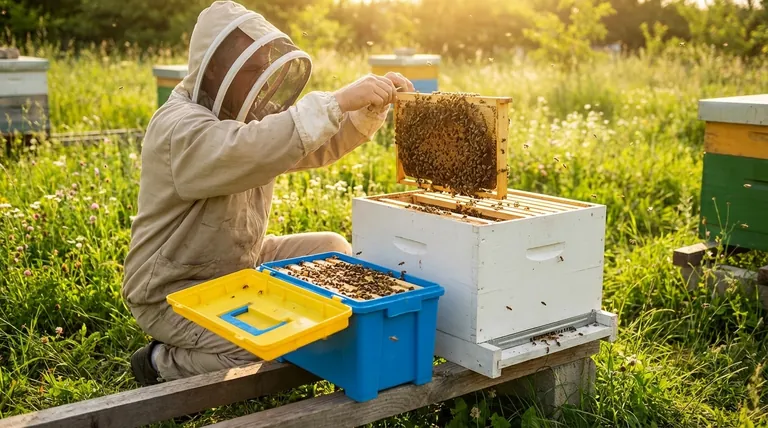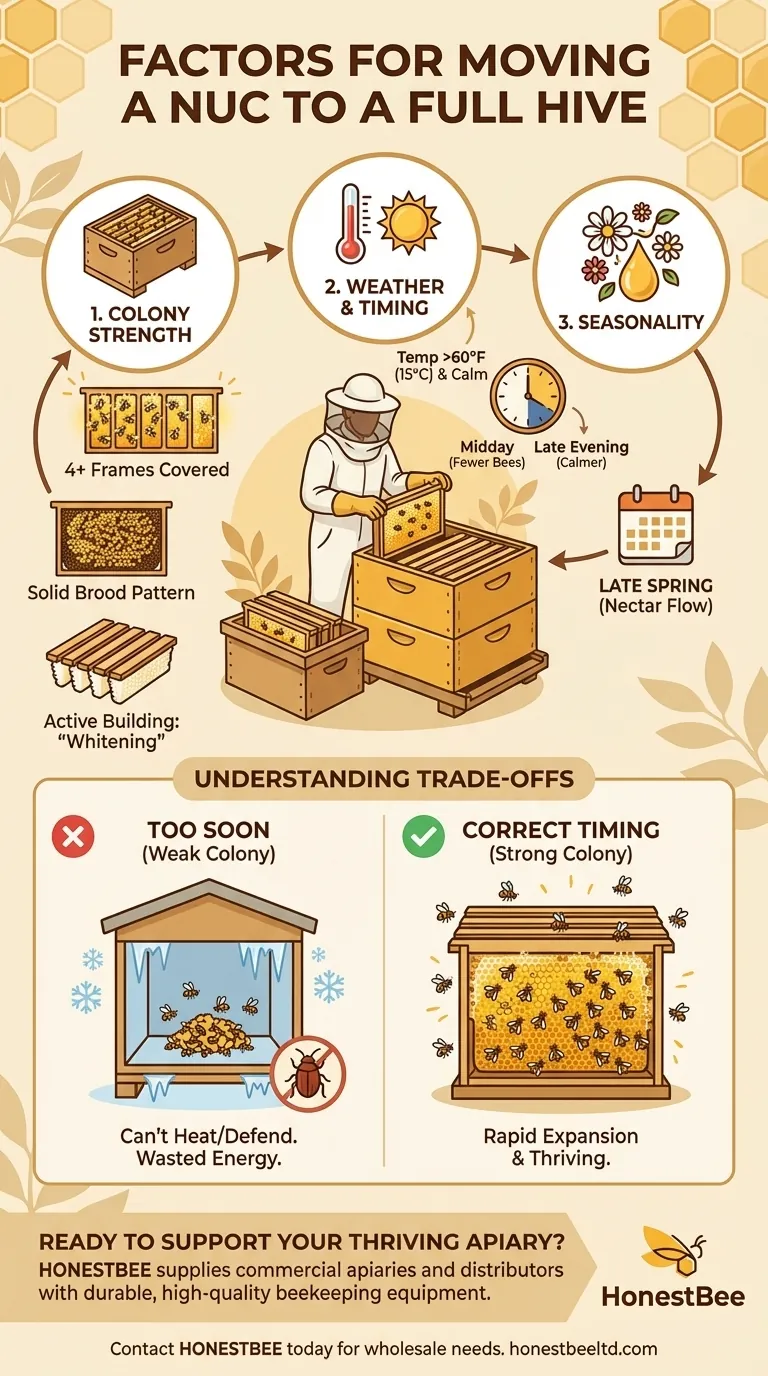Before all else, a successful transfer from a nucleus (nuc) colony to a full-sized hive hinges on three primary factors: the internal strength of the colony, the external weather conditions, and the time of year. A strong nuc, moved on a warm day during a period of growth like late spring, has the highest chance of thriving. The goal is to give the bees more space precisely when they are ready to use it, without adding unnecessary stress.
A common mistake is to think of the transfer as a simple scheduling task. The key is to see it from the bees' perspective: you are moving them into a much larger "house" that they must immediately heat, defend, and build out. The transfer is only successful if the colony is strong enough for this massive undertaking.

Assessing Your Colony's Readiness
Before you even consider the weather, you must first inspect the nuc itself. The bees will give you clear signals when they are ready for a larger home.
Frame Count and Bee Population
A standard five-frame nuc is ready for transfer when the bees are actively using at least four, and ideally all five, of the frames. When you pull a frame out, it should be well-covered with bees. This is the clearest sign that they are running out of space for brood, honey, and pollen.
Brood Pattern and Queen Health
The colony's future depends on a healthy, productive queen. Look for a frame with a solid, compact brood pattern, where eggs, larvae, and capped brood are clustered together. A spotty or scattered pattern can indicate a failing queen or disease, which should be addressed before any transfer.
Evidence of Active Building
Look for signs of new wax construction, often called "whitening" on the top bars of the frames. This indicates that the bees are in expansion mode and have the resources to build new comb, which is exactly what they will need to do in the new hive.
Timing the Transfer for Minimum Stress
Once you've confirmed the colony is ready, the next step is to choose the right moment. The timing of the move is about minimizing stress and preventing setbacks, particularly the loss of brood.
The Ideal Weather Window
Never transfer a colony on a cold, windy, or rainy day. The most critical rule is to avoid temperatures below 60°F (15°C). Opening the hive in colder temperatures can rapidly cool the developing brood, a condition known as chilled brood, which can kill larvae and set the colony back significantly. A warm, calm, and sunny day is perfect.
Choosing the Right Time of Day
You have two excellent options for the time of day, based on bee behavior:
- Midday (11 a.m. - 2 p.m.): On a warm day, a large portion of the foragers will be out of the hive. This means fewer bees are inside the box, making the transfer of frames less chaotic and reducing the number of bees you have to manage.
- Late Evening: As the sun sets, all the bees return to the hive and the colony tends to become calmer. Moving them in the evening ensures the entire colony settles into the new hive together overnight, minimizing confusion the next day.
The Importance of Seasonality
The time of year is paramount. Late spring is the absolute best time to move a nuc. Warmer temperatures are consistent, and more importantly, the bees are entering a nectar flow. This abundance of natural pollen and nectar provides the fuel they need to draw out wax, build new comb, and rapidly expand into their new home.
Understanding the Trade-offs: When to Wait
Sometimes the wisest decision is to do nothing. Moving a colony at the wrong time can be far more damaging than letting them stay in a cramped nuc a bit longer.
The Risk of Transferring Too Soon
Moving a weak nuc into a massive ten-frame hive is a common and serious mistake. A small colony cannot effectively thermoregulate the large, empty space. They will waste precious energy trying to keep the brood warm instead of gathering resources and expanding.
Furthermore, a small cluster of bees cannot defend the vast, empty territory against pests like wax moths or small hive beetles, which can quickly overwhelm and destroy a struggling colony.
The "Too Late in the Season" Problem
If you acquire a nuc in the late fall, transferring it can be a fatal error. The colony does not have enough time, warm days, or available nectar to build out the new frames before winter arrives. It is often much safer to overwinter the bees in their smaller nuc box, where they can more easily conserve heat and resources.
Making the Right Choice for Your Colony
Ultimately, your decision should be guided by the colony's needs, not a rigid calendar. Use these principles to make a sound judgment.
- If your primary focus is rapid spring expansion: Transfer a strong, bursting nuc on the first available warm day to give them the space they need to take full advantage of the nectar flow.
- If your primary focus is colony survival: If a nuc seems weak or it's late in the season, wait and allow the bees to build more strength in their smaller, more defensible space.
- If your primary focus is a smooth, low-stress transfer: Acclimate the bees by placing the nuc box next to the new hive for 24 hours before moving the frames in their original order.
Making the right decision is a matter of observing your bees and providing what they need, when they need it.
Summary Table:
| Factor | Key Consideration | Why It Matters |
|---|---|---|
| Colony Strength | At least 4 frames heavily covered in bees; solid brood pattern. | A weak colony cannot heat or defend a large hive, risking failure. |
| Weather Conditions | Warm, calm day; temperatures above 60°F (15°C). | Prevents chilled brood and reduces stress on the bees during the move. |
| Timing & Season | Late spring is ideal, during a nectar flow. | Provides resources for bees to build comb and expand rapidly into the new space. |
Ready to support your thriving apiary? A successful transfer is just the beginning. HONESTBEE supplies commercial apiaries and beekeeping equipment distributors with the durable, high-quality supplies needed for every stage of beekeeping. From nuc boxes to full hive setups, our wholesale-focused operations ensure you have the right equipment for healthy, productive colonies.
Contact HONESTBEE today to discuss your wholesale needs and how we can help your operation succeed.
Visual Guide

Related Products
- 4 Frame Plastic Nuc Boxes for Beekeeping Bee Nuc Box
- HONESTBEE Professional Long Handled Hive Tool with Precision Cutting Blade
- Black Plastic Beetle Barn Hive Beetle Trap for Beehives
- Modern Flat-Mount Hive Number Set for Beekeeping
- Professional Multi-Function Stainless Steel Hive Tool
People Also Ask
- What should a healthy brood nest in a nuc look like? A Guide to Strong Colony Development
- What are the advantages of choosing a nucleus hive over a package of bees? Get a Head Start with a Pre-Established Colony
- What are some uses for a nucleus in beekeeping? A Guide to Apiary Growth and Resilience
- How does installing a nuc differ from installing a bee package? A Guide to Starting Your Hive Right
- How many bees are in a nucleus hive? Get a Head Start with 10,000-15,000 Bees



















